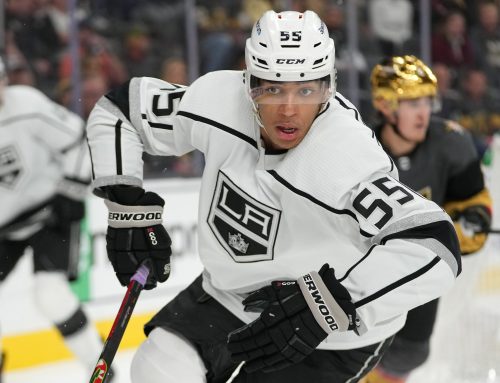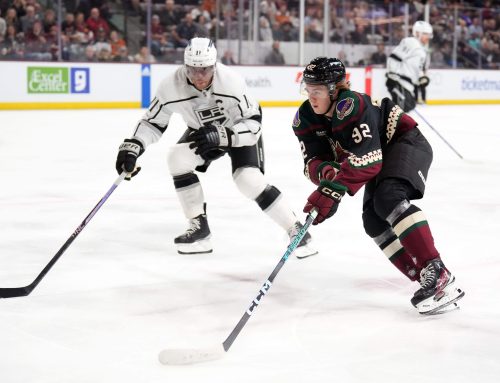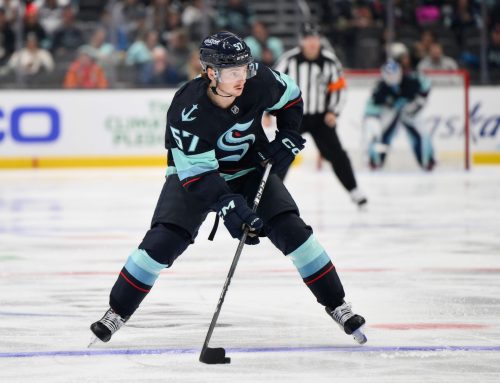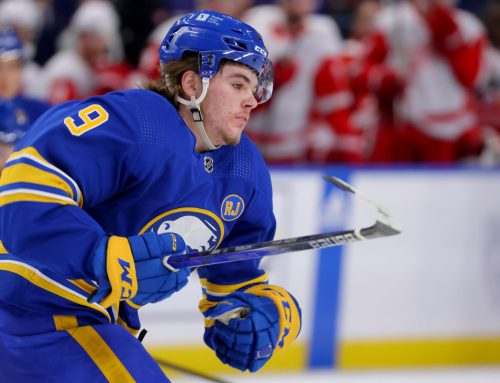The Journey: Insights from World Junior 2024 Tracking Data
Ben Gehrels
2024-01-06
Welcome back to The Journey, where we track the development of prospects as they excel in junior, make the NHL, and push towards stardom.
***
With the 2024 World Juniors now in the rearview (congrats to the US!), let's break down some of the more impressive, under-the-radar performances in the tournament. As usual, many of the players at the top of the various key microstat categories tracked by Mitch Brown and Lassi Alanen (check out their Patreon here!) are names fantasy managers are very familiar with.
For Canada, Macklin Celebrini (2024 eligible; 1st in Overall Game Score), Carson Rehkopf (SEA, 1st in Slot Passes/60), and Matthew Wood (NAS; 1st in Expected Primary Points) led the way. For the gold-medal-winning Americans, it was all the usual suspects: Frank Nazar (CHI; 1st in Controlled Zone Entries), Gabe Perreault (NYR; 1st in Primary Assists/60), Ryan Leonard (WAS; near the top in most offensive categories), Rutger McGroarty (WPG), and Will Smith (SJS).
Jani Nyman (SEA) and Jonathan Lekkerimaki (VAN) for Finland and Sweden respectively were shooting everything that moved. Filip Mesar (MON) finished first in Inside Play for Slovakia for capably getting pucks from the boards to the middle in all three zones. Most of the prospects we expected to excel did so. With that in mind, and with the annual caveat that these sample sizes are TINY, there is still a lot of intriguing data to sort through from this unique confluence of international prospects.
Here are some interesting microstat results from the tournament that most caught my eye, starting with the Ducks Swiss star-in-the-making, Rodwin Dionicio.
Rodwin Dionicio (Switzerland/Anaheim Ducks)
Alanen and Brown have been adamant about Dionicio since well before the 2022 draft, even though an NHL team did not take a chance on him until Anaheim took him in the fifth round the following year in 2023. He is a big-bodied (6-2, 214 lbs) defenceman who blew up in 2022-23 after a mid-season trade; his point-per-game rate ballooned from 0.41 to 1.3, and he finished with 43 points in 33 games for Windsor (OHL). His scoring has slowed somewhat this year, which has involved another trade, but he is still scoring a point per game in the OHL in 2023-24.
The aspect of Dionicio's game that has stood out all along is his deceptive playmaking. He has a well-stocked arsenal of dekes, passes, and shots that he pulls from with very little hint as to what he will do next. His tracking data from the 2023 OHL season is almost a mirror image of what he accomplished at the World Juniors—except for the fact that his defensive rating is now also elite.
He has always excelled in transition and in the offensive zone. In fact, he maxed out eight of the 18 tracked categories in the OHL data: Primary Assists/60, Slot Passes/60, Controlled Entries/60, Cross-Lane plays/60, Boards to Middle Plays/60, Advantages Created/60, Primary Point Involvement/60, and Game Score/60. These stats are all relative to the other skaters in the data set, so maxing out a category essentially means leading it.
Get the picture? Dionicio makes offense happen.
He carries and protects the puck extremely well in transition, then consistently creates dangerous offensive plays once inside the opposing blue line. At the WJC, he again maxed out four categories and came close on six others, and this was playing for Switzerland, who were outscored 20-11 and came away with only one win. Though he scored a 71 defensive rating in the OHL data last year, Dionicio finished this tournament with a score of 94 on defense. His entry prevention % remained about the same, but he made significant strides with his Defensive Plays/Corsi Against and, most notably, his Retrieval Success %.
So why did NHL teams balk at such a unique, capable defender? His poor skating.
Elite Prospects gave his skating a 3.5 rating last year (NHL average = 5), which was actually improved from the year before when he was first eligible for the draft. Top speed and edgework have been significant hurdles for him: "he's always on his heels, limiting speed and agility" (EP Draft Guide 2023). With that in mind, I feel that his marked improvement in retrieval success % during the World Juniors, where again he was wildly outmatched versus what he is experiencing in the OHL, signals an improvement in this area. Successful retrievals require speed, agility, physicality, and awareness. There is still room for improvement here, of course, but this is a significant positive sign.
As a final interesting wrinkle in case you had not heard, the Spitfires experimented at the end of the last year with playing Dionicio on the wing at forward. Brown noted that "Dionicio's speed and edge work aren't nearly as problematic on the wing," and that his ability to manipulate defenders on offense was on par with high-end forward prospects—like teammate-at-the-time, Shane Wright (SEA). If everything comes together for the young man, we might have a potential Dustin Byfuglien 2.0 on our hands.
Ty Nelson (Canada/Seattle Kraken)
While he was shaky defensively, Nelson had a notable impact on offense for Canada at this tournament. The former third-round pick (2022) had only three assists and no goals across five games but led all skaters in Shots/60 and generated significant Expected Goal (xG/60) and Primary Assist (xA1/60) numbers. The high xG numbers but low actual production suggest that he (and Canada in general) ran into some poor puck luck and hot-handed netminers (ie. Czechia's Michael Hrabal, ARI).
Although Nelson struggled with making plays and preventing zone entries, he was incredibly involved in the offensive zone.

The full picture here raises some interesting questions: why did Nelson excel in xA1/60 but struggle with Slot Passes/60? The fact that he also struggled with Cross-Lane Plays and Boards to Middle Plays suggests that opposing defences were able to keep him to the outside and that he consistently failed to attack the middle of the ice.
Next his sky-high xG/60 clashes with his very low xP1 Involvement %, which is "the player’s percentage of the team’s total xG that the player either shot or set-up" (Patreon). If I am reading this right, it looks like Nelson took a lot of low-danger shots (high shots/60) that generated a high xG score via quantity rather than quality and thereby did not contribute meaningfully to his team's overall xG. In other words, both his shots and passes were not very dangerous.
Nelson made a lot of noise on offense, but his bark was worse than his bite. That insight combined with his poor defensive metrics paints a picture that is not very flattering in terms of his NHL outlook, unfortunately.
Plus, the offense-only pattern evident in his tournament scores of 100 (offense), 82 (transition), and 37 (defense) mirrors what Brown tracked from him during his OHL draft year, when he scored ratings of 76 (offense), 61 (transition), and 48 (defense). Again, take this all with a grain of salt, but buyer beware in fantasy!
Martin Johnsen (Norway/Undrafted)
Although Norway was relegated to Division 1A after a 5-4 loss to Germany at the end of the tournament, there were some bright spots for this oddly lackluster hockey country.
Despite Sweden and Finland being top hockey nations worldwide, I could not name five Norwegian NHLers off the top of my head. Why is that? There is Mats Zuccarello (MIN), of course, and I had a hockey card as a kid of an Avalanche player named Anders Myrvold. Mathias Emilio Pettersen is a depth Calgary prospect, and Michael Brandsegg-Nygård is shaping up to be the country's best since Zuccarello. But for whatever reason, Norway has lagged behind its Scandinavian counterparts in hockey.
The player who stood out the most in the data for Norway was not actually Brandsegg-Nygård, who led the team in scoring with five points in five games. It was an overager named Martin Johnsen. He appears again and again at the top of the entire tournament data set with the best and brightest names in the sport. Check out his results:

Excellent playmaking results with a ton of high-danger plays in the offensive zone. Solid success in transition, especially given the challenging competition, and his defensive impacts are also solid. He was one of the only straws stirring the drink for Norway out there, and that is worthy of note despite the relegation.
He is already playing in his Draft+2 season, however, meaning he has been passed over by every NHL team two years in a row. That makes me wonder the same question about him that I had about Dionicio: what gives?
His metrics in this tournament against his peers were fantastic, so how about his historical production? 23 points in 29 J20 Nationell games in his Draft year is more or less on brand for a higher-end drafted prospect from that league. He then returned to the J20 in his D+1 and showed some progression (37 in 34) on the score sheet. Usually we would expect NHL-bound prospects to move on to the Allsvenskan or SHL by that point, but playing in the J20 at age 18/19 is not unusual by any means.
But then he made the odd choice to cross over to play in the top Norwegian men's league in 2023-24, where he is tied for 16th league-wide in points per game with 1.13. I have never seen anyone cross over to the NHL from the Norway league, and neither has the Hockey Prospecting model, which is unable to generate any projection numbers for him this year.
This level of success against his peers is absolutely worth noting, and it seems as though it would be in an NHL team's best interest to take a swing on Johnsen late in the 2024 draft. But the odds certainly seem stacked against him—much like Liam Kirk, 24, who was signed by the Coyotes back in 2021 after he scored 9 points in 7 games for England at the World Championships.
That was a similar case of a no-name player excelling for a terribly outmatched team, and it became a success story of sorts. But after a couple brief looks in the AHL, Kirk ended up in the ECHL before returning to Europe. He has performed well in both the Liiga and top Czech league since then, but his NHL likelihood is basically zero at this point. Making the NHL is so, so difficult.
Johnsen seems destined to follow a similar path to Kirk, but hey, you never know! And as many voices of reason repeatedly stated online during the World Juniors, these are just 18- and 19-year-old kids playing the game of hockey. Just because most of them will never make or excel in the NHL does not make their achievements any less significant; it just means that they will not make the cut for our ruthless fantasy purposes.
***
Other insights of note to dig into at a later time:
- Carson Rekhopf is known for his goal-scoring but produced significant playmaking results at the World Juniors.
- Veit Oswald was Germany's Martin Johnsen: he finished first overall in the data set for offensive involvement relative to his teammates.
- My impression of Leeni Hämeenaho (NJD) from his draft year was that he was a safe, boring pick without a ton of dynamism or upside. This tournament, plus his 17 points in 26 Liiga games as a 19-year-old, has me rethinking that assessment. He is moving into a category of players in my mind that is highlighted by Jimmy Snuggerud and Jiri Kulich: safe-floor players in their draft year who seem very likely to make the NHL because they have many fundamentals vital to thriving in the pro game but seem to lack certain high-end offensive traits who then take a notable step forward in that area in their D+1 to become complete players. High praise in a big mouthful of a sentence.
- He really clicked with Jani Nyman (SEA) for Finland, who I would also like to dig into further. Nyman is yet another second-round pick by Seattle who is trending extremely nicely. Second-round picks have become the Kraken's bread and butter.
- Although Jonathan Lekkerimaki (VAN) dominated my Twitter/X feed during the tournament with his voracious shot-first mentality, his teammate Noah Ostlund (BUF) was the true star for Sweden according to the data. Ostlund is very, very talented and yet still continues to fly under the radar somewhat in that he is probably not considered a true blue-chipper in most circles.
***
Thanks for reading! Follow me on Twitter @beegare for more prospect content and fantasy hockey analysis.





 BOS
BOS TOR
TOR CAR
CAR NYI
NYI WPG
WPG COL
COL VAN
VAN NSH
NSH DAL
DAL T.B
T.B FLA
FLA VGK
VGK PIT
PIT SEA
SEA
